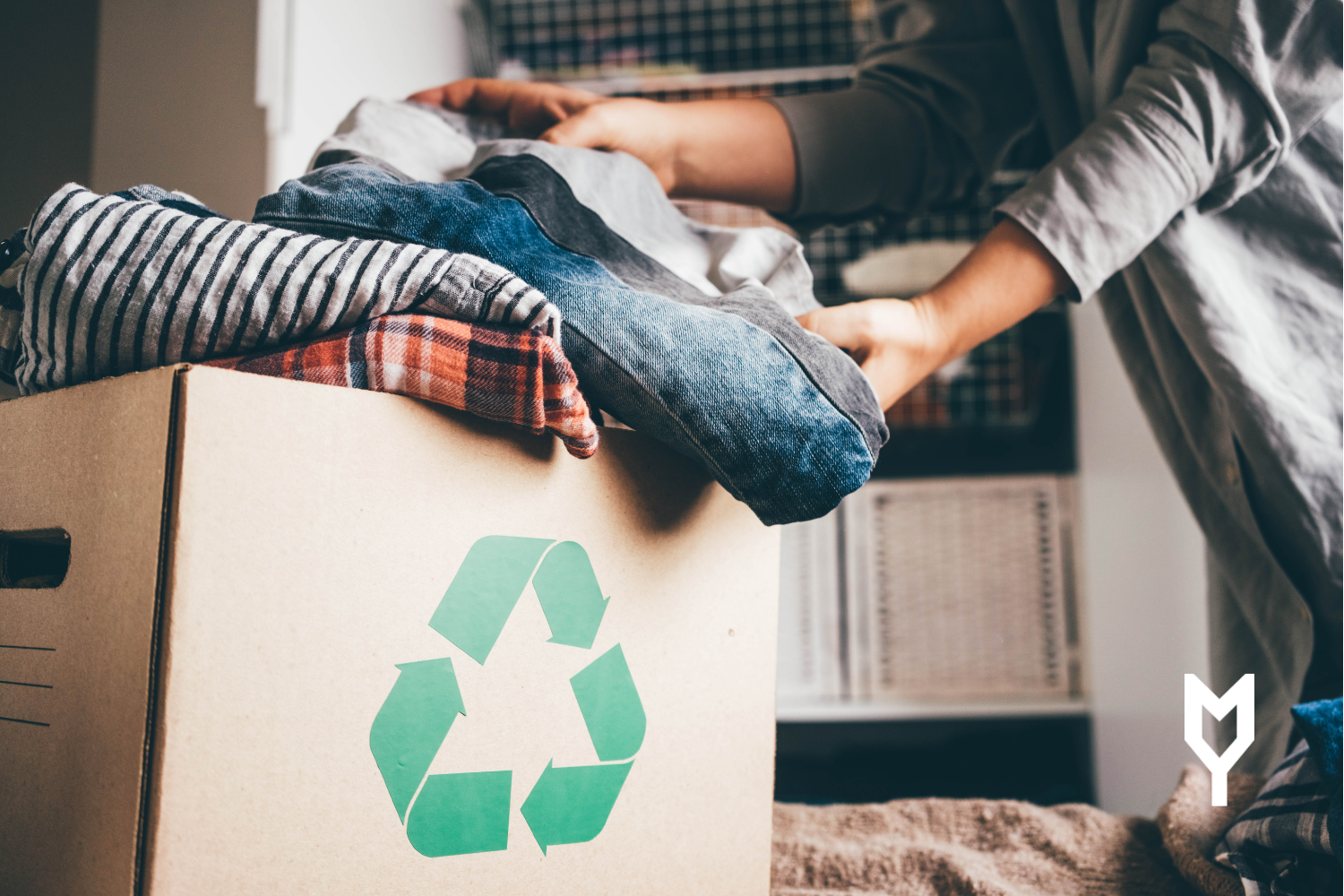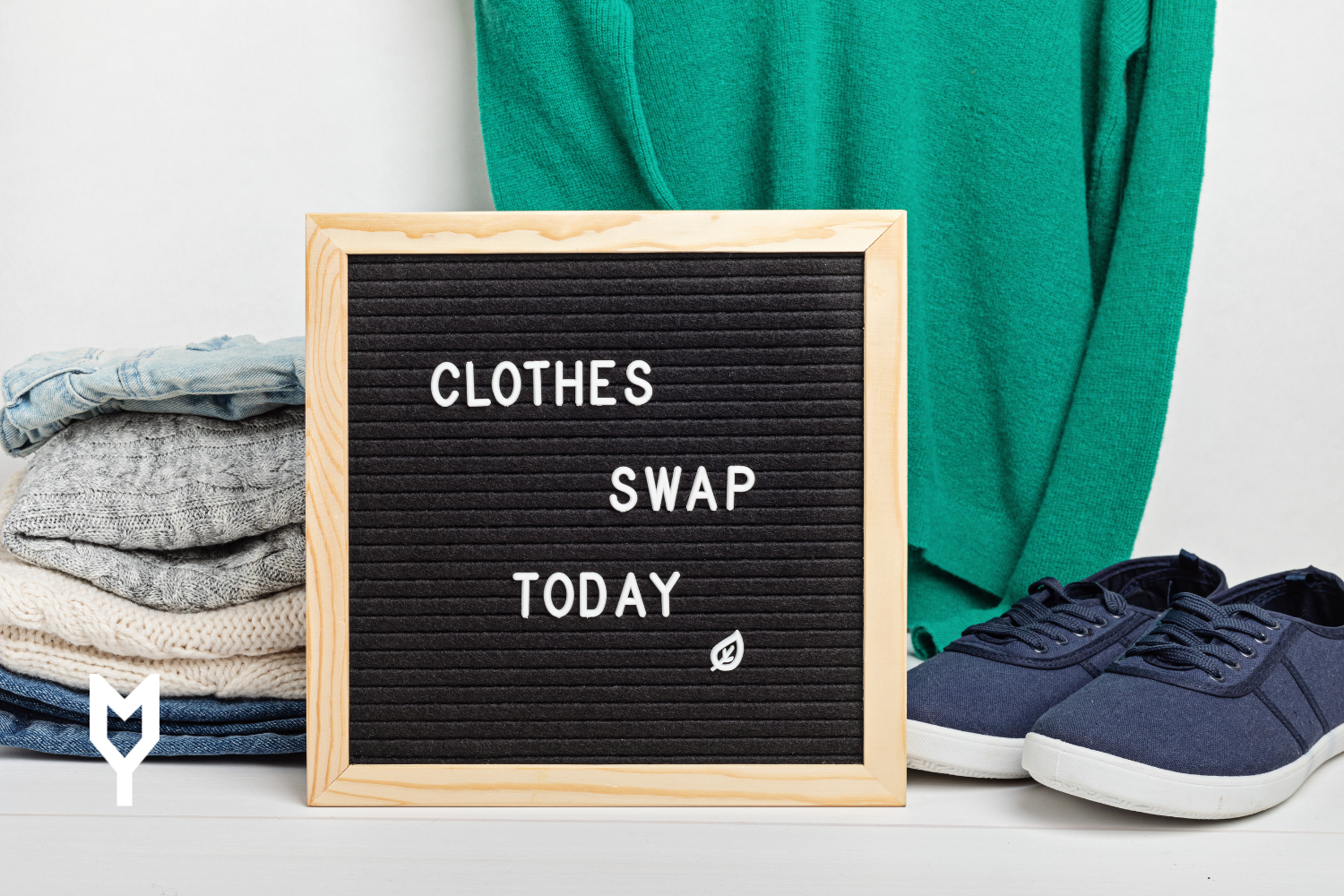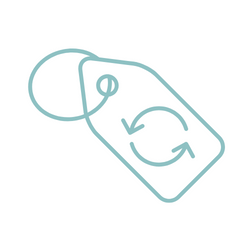What to do with old textile?
Discover tips on how you can give old textile a second chance. Together with the fashion revolutionary Kamila Boudová from the SLOU project, of which we have been a long-term partner, we will present several options for more sustainable handling of used clothing. You will also learn how we use old textile in our production at MERCHYOU.

From time to time, it pays to go through the wardrobe and discard less worn or old clothes. Not only can we keep what we really wear and love, and thus save a lot of time and frustration in choosing our outfit, but by cleaning things around us we can also get a feeling of some relief, clarity and new energy, which is definitely worth it.
The solution to the question of what to do with discarded clothing is first and foremost about the purchase itself. The conventional fashion industry is famous for its fast collection cycles and purchases, which place an enormous burden on our planet. The pressure for constant and large-scale production then affects all aspects of production. To make cultivation profitable, toxic pesticides are used, so the soil is degraded and there is no time to regenerate. The production consumes a large amount of energy, pollutes water resources, and the impacts reach the end consumer, who gets poorly produced clothing with degraded fiber, which can withstand a few washes before losing its shape and the need to buy new one occurs. All of this then supports unsustainable textile production further.
What should we do? The first thing we can do is to choose quality textile that have been sustainably produced and is friendly towards natural resources and people. In addition, if we take proper care of every piece we own, it will last us a long time so it is not necessary to constantly buy new and new clothes. Take a look at our article How to take care of your clothes, where you can find useful tips for maintaining the quality of the textile.
 However, the texile we no longer want does not always have to end up in a landfill. It almost always has a certain value that can still be used. Let's take a look at the solutions for worn clothes in wardrobes and how fashion revolutionary Kamila Boudová approaches these pieces. Kamila educates in the field of sustainable fashion and leads the SLOU project, of which we have been a long-term partner.
However, the texile we no longer want does not always have to end up in a landfill. It almost always has a certain value that can still be used. Let's take a look at the solutions for worn clothes in wardrobes and how fashion revolutionary Kamila Boudová approaches these pieces. Kamila educates in the field of sustainable fashion and leads the SLOU project, of which we have been a long-term partner.
WHAT CAN BE DONE WITH USED CLOTHING
REPAIRING
A large amount of clothing ends up in a landfill just because it is somehow damaged. However, a broken zipper, a torn seam or a lost button do not immediately mean that the textile should automatically become waste. All we have to do is invest a little time or money in its repair and it can serve us well for a long time. Before you decide to give away a damaged piece of clothing, think about whether it can be repaired. Maybe by repairing it, you will even give it a new touch and you will like it even better. If you think that your repairing abilities are not enough, contact experienced professionals. However, if you dedicate your own efforts and care, you will see that you will appreciate the piece even more!
 Kamila, SLOU: "If you love it, there is nothing to question. You repair the hole in the sweater a hundred times, you get the shoes resoled for the sixth time. I have boots that I wanted to ‘get rid of’ after only two seasons, because at that time I still ‘wanted new ones’. In the end, we spent seven or eight winters together. Always before the season, I got them resoled, just like the other leather loafers, which also had seven happy years with me. If you know that your shoes will last that long, then you have no problem buying the shoes of your dreams! It was no problem for me to invest bigger amount in dream shoes from a Czech designer made in Zlín. So fixing will help you set up a better mindset!
Kamila, SLOU: "If you love it, there is nothing to question. You repair the hole in the sweater a hundred times, you get the shoes resoled for the sixth time. I have boots that I wanted to ‘get rid of’ after only two seasons, because at that time I still ‘wanted new ones’. In the end, we spent seven or eight winters together. Always before the season, I got them resoled, just like the other leather loafers, which also had seven happy years with me. If you know that your shoes will last that long, then you have no problem buying the shoes of your dreams! It was no problem for me to invest bigger amount in dream shoes from a Czech designer made in Zlín. So fixing will help you set up a better mindset!
CREATIVITY AND UPCYCLING
Sometimes the clothes don't even have to have a specific defect, but for example we don't fit the size, we don't wear it as much as we thought, we don't like a certain part of it or it simply lost its charm. Upcycling, or the transformation of an old and unnecessary product or material into a new one that is reusable, presents many ways to give textile a new life. Don't be afraid to be creative - tear, cut, change the colour so that you like the item again.
You can also try to figure out how textile can be used for other purposes. You can easily create pillowcases, bags, grocery bags, pencil cases or even puppets for children and bedding for your pets! There is a lot of interesting inspiration all over the internet, but we believe that you will come up with even more creative ideas yourself. If you don't dare to create it yourself or you have an idea that is more demanding, you can use sewing and upcycling workshops, where you just need to bring the material and agree on what you would like to have made.
 Kamila, SLOU: "Yup, I've already made a sock puppet for my daughter. Otherwise my favourite upcycling discipline is ‘cropped top’. I like to wear high waists so I cut a T-shirt or a blouse under my chest so that a strip of naked skin can be seen. It's trendy right now! And let's face it, in ten years I may not be able to afford such styles... :)"
Kamila, SLOU: "Yup, I've already made a sock puppet for my daughter. Otherwise my favourite upcycling discipline is ‘cropped top’. I like to wear high waists so I cut a T-shirt or a blouse under my chest so that a strip of naked skin can be seen. It's trendy right now! And let's face it, in ten years I may not be able to afford such styles... :)"
SWAPPING
 The so-called swap is the exchange of things that you no longer need for others. All you have to do is find out where a swap event is taking place in your area, bring textile items you no longer want, and if you like something that someone else has brought, you can take it home. Different swap events have different rules. Sometimes the amount you can take away is limited or the minimum number of pieces you have to "put" into the swap is set or the piece-by-piece rule applies. Some events are free, some have an entrance fee. Either way, you should always bring washed, clean and wearable clothes to every swap event. And if there is no swap meeting in your area at the moment, do not despair - you can easily organise your own at a friend's home!
The so-called swap is the exchange of things that you no longer need for others. All you have to do is find out where a swap event is taking place in your area, bring textile items you no longer want, and if you like something that someone else has brought, you can take it home. Different swap events have different rules. Sometimes the amount you can take away is limited or the minimum number of pieces you have to "put" into the swap is set or the piece-by-piece rule applies. Some events are free, some have an entrance fee. Either way, you should always bring washed, clean and wearable clothes to every swap event. And if there is no swap meeting in your area at the moment, do not despair - you can easily organise your own at a friend's home!
Of course, with regards to the anti-pandemic measures in place ☺
 Kamila, SLOU: "The SWAP party is a part of every SLOU DAYS we organise and with the beautiful clothes I snatched there, I can put together some super chic outfits that fit into Paris, where I live. I also like the term 'community swap party' or put unwanted clothes in a bag in front of the house with the words 'serve yourself'. It will certainly come in handy for someone. Just make sure it doesn't rain!"
Kamila, SLOU: "The SWAP party is a part of every SLOU DAYS we organise and with the beautiful clothes I snatched there, I can put together some super chic outfits that fit into Paris, where I live. I also like the term 'community swap party' or put unwanted clothes in a bag in front of the house with the words 'serve yourself'. It will certainly come in handy for someone. Just make sure it doesn't rain!"
TEXTILE CONTAINERS
 Textile containers are a relatively widespread and easily accessible option for used textile. However, as with other recycling containers, it is important to follow certain rules: in the container, we should only put clothes that are clean, dry, not damaged and packed in a sack or bag. We recommend studying the instructions on the containers, which also determine what belongs in the container and what does not. In most cases, you can put clothes, shoes, accessories, or toys in them. On the contrary, blankets and pillows, fur coats or carpets are often not allowed.
Textile containers are a relatively widespread and easily accessible option for used textile. However, as with other recycling containers, it is important to follow certain rules: in the container, we should only put clothes that are clean, dry, not damaged and packed in a sack or bag. We recommend studying the instructions on the containers, which also determine what belongs in the container and what does not. In most cases, you can put clothes, shoes, accessories, or toys in them. On the contrary, blankets and pillows, fur coats or carpets are often not allowed.
Textile containers can be of various natures though. It pays to check the company that manages the containers and get a closer idea of how it specifically handles the textile. Not all clothing ends up with non-profit organisations. After sorting, part of the clothing is processed and used in industrial production, for example as cleaning cloths.
However, there are cases of especially commercial companies that resell textile to second hands. It also depends on which charities the clothes are given to. For example, sending textile to Africa has gradually become a burden rather than a help. There is already so much textile in developing countries that they often end up in landfills or lie on the streets and destroy the local nature (source). Therefore, let's not be afraid to ask and find out what is really going on with the textile we give over, and what percentage will find an adequate use.
 Kamila, SLOU: "Containers are great mainly because we learn to sort textile. Would you throw a PET bottle in the trash? No? Clothes are 60% oil, just like a PET bottle, so they also deserve separation. What happens to container clothing today often causes more problems. But this is not always the case and it is important to learn how to sort clothes, because, and I believe it, the time when we will recycle more than the current one percent of textile waste is approaching."
Kamila, SLOU: "Containers are great mainly because we learn to sort textile. Would you throw a PET bottle in the trash? No? Clothes are 60% oil, just like a PET bottle, so they also deserve separation. What happens to container clothing today often causes more problems. But this is not always the case and it is important to learn how to sort clothes, because, and I believe it, the time when we will recycle more than the current one percent of textile waste is approaching."
CHARITY SHOPS AND DONATING
Donating textile in good condition to our family, friends or charity is a much better option than simply throwing it away. Not only will clothing not become a waste and we will give it a second chance to make good use of it, but above all we can please others and feel good.
There are a lot of charity shops and second-hand shops, which then pass on this joy in the form of sales earnings or sometimes a given piece of clothing to non-profit organisations and those in need. At the same time, you can support charity directly by purchasing in these stores.
 TIPS for charity shops
TIPS for charity shops
Local charity shops, organisations such as I:CO – they collect in their partner locations in more than 60 countries, sort the items and either reuse or recycle.
Before choosing a charity shop, we recommend that you check how many donations are actually given to the charity and where it is needed. As with textile containers, there are companies that will make only a minimal contribution or send your gift where it is unlikely to reach its potential. Feel free to ask and verify.
 Kamila, SLOU: "Donating clothes to a second-hand or charity shop is even better than putting it in a container, because you don't send it on a trip around the world - you turn it over locally."
Kamila, SLOU: "Donating clothes to a second-hand or charity shop is even better than putting it in a container, because you don't send it on a trip around the world - you turn it over locally."
RE-SELLING
Of course, if the clothes are still in good condition and wearable, you can also try to sell them and get part of the value back. There are many websites and mobile applications, such as Vinted, that provide a platform for selling or buying second-hand clothes. You can also organise a so-called garage sale, where you put your things in front of the house and sell them to neighbours and passers-by. Try to challenge your neighbours and organise a joint sales day. Maybe you will find the treasure you have been looking for for a long time at your neiigbour's stand!
 Kamila, SLOU: "I have to admit that I haven't sold anything in a long long time. When I buy something, it's either love for life or I pass it on as a gift. On the other hand, I bought a divine dress from a young lady at Vinted last year. I literally look like a Greek Goddess in it!"
Kamila, SLOU: "I have to admit that I haven't sold anything in a long long time. When I buy something, it's either love for life or I pass it on as a gift. On the other hand, I bought a divine dress from a young lady at Vinted last year. I literally look like a Greek Goddess in it!"
COMPOSTING
One way to dispose of old clothes is to simply put them in a compost. However, this is only possible with 100% natural materials such as cotton, flax, hemp, bamboo, or similar. In order for the textile to really decompose and in no way damage the compost and soil, it must not be degraded by toxic substances and dyes during its cultivation and production. Therefore, before you put your old T-shirt in a compost, it is good to make sure that it is really compostable.
 Kamila, SLOU: "I guess it's thanks to the fact I'm the "fashion revolutionary" that I have a few pieces of clothing in my closet that are made so that they can be composted. I have a sweater made of uncoloured alpaca yarn from the Animana brand. All you have to do is cut off the label. The sweatshirt made of organic cotton from La Petite Mort, which is sewn with organic threads and even the label is organic, so it is ready for compost as it is. Or the underwear from the Slovak brands Créeme, which I would have to take the rubber bands out of and cut the label off, but otherwise it is also ready!"
Kamila, SLOU: "I guess it's thanks to the fact I'm the "fashion revolutionary" that I have a few pieces of clothing in my closet that are made so that they can be composted. I have a sweater made of uncoloured alpaca yarn from the Animana brand. All you have to do is cut off the label. The sweatshirt made of organic cotton from La Petite Mort, which is sewn with organic threads and even the label is organic, so it is ready for compost as it is. Or the underwear from the Slovak brands Créeme, which I would have to take the rubber bands out of and cut the label off, but otherwise it is also ready!"
In our offer, you can find Natural Raw variants of products from Stanley/Stella, which are naturally biodegradable thanks to the sustainable production. Take a look at our article Natural biodegradable textile we offer!
MERCHYOU PRODUCTION
 And how do we at MERCHYOU dispose of textile? For example, we use textile that has been damaged during the production for further test prints. We also use it as cleaning cloths, which we wash and use repeatedly. We finally sell the remaining and no longer usable textiles to the company that uses it to produce insulating materials.
And how do we at MERCHYOU dispose of textile? For example, we use textile that has been damaged during the production for further test prints. We also use it as cleaning cloths, which we wash and use repeatedly. We finally sell the remaining and no longer usable textiles to the company that uses it to produce insulating materials.
We believe that in clothing, especially the sustainable one, there is a significant value that can be used repeatedly in the long term and with regards to nature protection. We have a lot of options to choose from when disposing our used clothing. So let's choose wisely and give the materials a second chance! 💚

